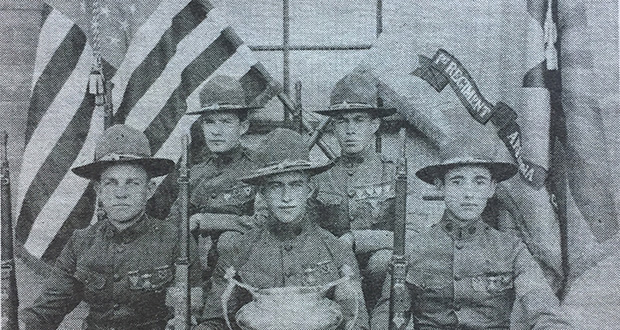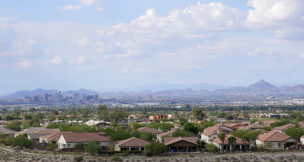The Short-Lived Papago Saguaro National Monument
Arizona Capitol Reports Staff//June 16, 2006//[read_meter]
The Short-Lived Papago Saguaro National Monument
Arizona Capitol Reports Staff//June 16, 2006//[read_meter]

Papago Park, known as Papago Saguaro National Monument from 1914-1930, features many interesting plants and geologic formations, such as Hole-in-the-Rock, pictured here.
Shortly after statehood in 1912, the Phoenix and Maricopa County Board of Trade began an effort to have what is now Papago Park declared either a national park or a national monument. Originally, the committee recommended the creation of a “…National Cactus Park… as Yellowstone National Park, the Yosemite National Park, and the Mount Rainer National Park.”
The General Land Office was not interested in the proposal and replied to Rep. Carl Hayden that “…topographic conditions seem to offer nothing but scenery, and the National Monument Act of June 8, 1906, does not provide for reservation of public land for the purpose of protecting scenery.”
Additional information was submitted to the General Land Office, including seven dime store postcards showing Hole in the Rock, giant cacti, and yucca palms. After further review, President Woodrow Wilson signed proclamation No. 1262 in 1914, creating Papago Saguaro National Monument. He justified its creation by saying it contained “…splendid examples of the giant and many other species of cacti and the yucca palm…which are of great scientific interest, and should, therefore, be preserved…” Almost 2,100 acres were included in the monument.
At its zenith, the Papago Saguaro National Monument had nearly 5,000 visitors a year. Commercial pressures were an immediate concern for the keepers of the monument. Local merchants were known to paint advertisements on the rocks within the monument.
Once the National Park Service took over the area, they received requests to develop portions of the monument into enterprises such as a golf course, a community hospital for soldiers suffering from tuberculosis, a large auto campground, an airfield, waterfalls, tennis courts, ball fields, and a convention facility, all in an effort to make it a “world attraction.” The National Park Service rejected all these proposals.
In the 1920s, oil companies wanted to drill for oil within the monument. These requests were rejected. James Reed had claimed 160 acres, including Hole in the Rock, as a mining claim. Twenty years earlier, Charles Poston, the father of Arizona, had also claimed ownership of Hole in the Rock. Reed eventually wanted to trade his claim for 270 acres. He said “…in making this exchange I am practically giving the park to Arizona.” The GLO called Reed “…a shrewd land swindler.” The Department of Justice finally rejected Reed’s claims.
By the early 1930s, the demands of the nearby communities spelled the end of the Papago Saguaro National Monument. The employees of the National Park Service noted there were many homeless people living in the monument. Also, parts of the park were being used as illegal dumping sites.
After 16 years, the Papago Saguaro National Monument became one of only three national monuments ever turned back to local control.
The state of Arizona quickly built the Hunt Bass Hatchery thereafter, which released more than 175,000 bass and perch every year into streams and lakes around Arizona. News reports of the time indicated “Arizona’s newest industry is commercial fishing, the markets being New York and even Los Angeles; fish are being hauled 3,000 miles across the continent and sold on the eastern seaboard.” In 1932, Del Webb constructed the pyramid known as Hunt’s Tomb overlooking the Hunt Bass Hatchery.
The state of Arizona, the city of Tempe, the Salt River Project, and the War Department all received lands from the Saguaro Papago National Monument for other uses.
— Mike Miller. Photo courtesy of Arizona State Library, Archives and Public Records, Archives Division, Phoenix, #96-4056.

















